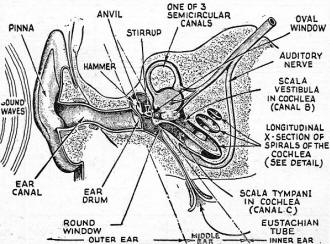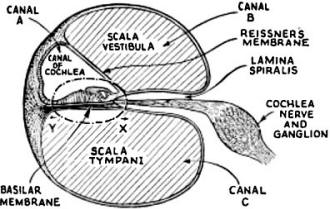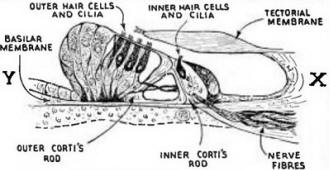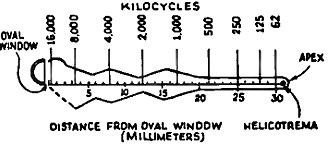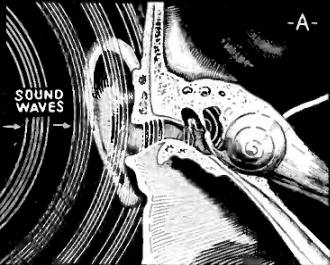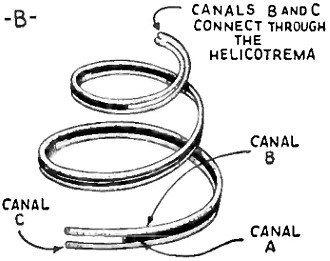How Do We Hear? Part II
|
|
A story in an electronics magazine on the physics and biology of the human ear is as relevant today as it was in 1936 when this appeared in Radio-Craft. Back then, creating sound in an efficient and effective manner for consumer, commercial, and military purposes was a relatively new science. Thomas Edison introduced his phonograph in 1877. While it did not feature an electrically driven speaker, research determined the shape, size, and material composition of the mechanism that converted minute grooves etched into the surface of a cylinder into sound pressure great enough for perception. Alexander Graham Bell's telephone of the same era (1876), used an electromagnetic coil to power a speaker membrane. 40 years later, radios were appearing everywhere and the race was on to provide high fidelity sound as a means to differentiate quality models from lesser models. Much research - the first of its kind - was performed on the workings of the human in an attempt to quantify its functional parameters - frequency response, sound level range, pain levels, damage-causing mechanisms, etc. Modern cellphones rely on new research related to bone conduction of sound and noise cancellation in addition to all the longstanding issues. Note: Part I of this article can be read on the American Radio History website. How Do We Hear? Part II Amplifiers and reproducers can easily be overloaded - but few people know that the human ear can also be overloaded; and when it is, the brain hears sounds that have not reached the ear! Read how hearing differs. N. H. Lessem Part II Fig. 1 - This illustration is repeated here to avoid the necessity of referring to Part I for the reference figure. Fig. 2 - A cross-section detail of the cochlea showing the three canals. The dotted portion is enlarged in Fig. 3. Fig. 3 - Corti's organ, showing the termination of the nerves in hair cells and hairy cilia.
Fig. 4 - The frequency characteristics along the length of basilar membrane. Fig. 5A - A cut-away view of the ear. Note how the sound waves, impinging on the eardrum, are transmitted by the three bones in the middle ear to the liquid of the inner ear.
Fig. 5B - Diagram of the positions of the cochlea canals. It will be noticed that canals A and B are interconnected, while canal C is closed at both ends. This discussion on how we hear and why we do not all hear alike brings to mind the odd case of a very able Service Man, a friend of the writer, whose ears, unknowingly to him, responded only to the middle portion of the audio frequency spectrum. One day he was sent to service a radio receiver, the complaint on which was: "annoying whistle." When he arrived and turned on the set he could find nothing wrong with it. Calling the lady of the household, he asked, "What seems to be wrong with the set, it plays OK?" "Why, that wheezing whistle," replied the lady, "it wasn't there when we first bought the set and it's very annoying." "But I don't hear anything now, lady, maybe it's cured itself." But the lady was steadfast. Had this Service Man been a less broadminded fellow he might have considered the lady "nertz" and said that nothing could be done about it. Instead he called his office and asked that another man be sent over immediately. Much to his surprise, however, this second man corroborated the lady's story. The whistle was a high-pitched "wheeze" in the neighborhood of 4,500 cycles, but his ears could not respond to that high frequency. Similarly, he was not able to distinguish by ear the presence of a hum frequency reported by the same customer. However, in this instance he was able to detect the sound by bone conduction, by holding one end of a screwdriver in his teeth and touching the other to the loudspeaker. Now this Service Man couldn't possibly enjoy the same degree of appreciation of a fine philharmonic band as experienced by a person whose ears responded to frequencies ranging up to 16,000 or 18,000 cycles and down to less than 100 cycles. Instead, he would lose practically all the high notes of the violin and other high-pitched instruments; and the low (fundamental) notes of the kettle drums and other low-pitched instruments. Why is it, then, that not all of us interpret identical sounds similarly? Why is it that the note "A" on the piano, for instance, may be "heard" as differently-sounding "piano tones" by two persons side-by-side? The Ear Mechanism Part of the explanation has been given to you in Part I, but to get a clearer picture of how the entire ear mechanism looks let us travel with the sound waves as they progress from the outer air throughout the entire structure of the ear. Neglecting the pinna, which is merely a collector, the sound waves in the air (which are nothing but a varying pressure of the air molecules) in impinging upon the eardrum force this diaphragm to vibrate. In its inward motion it presses against the hammer of the 3 bones in the middle-ear, the hammer in turn presses against the anvil, and the anvil against the stirrup, which finally makes contact with the tiny diaphragm in the oval window. On the other side of this diaphragm is the liquid of the inner ear. Now, since liquid has a considerably greater density than air, it is necessary for the oval membrane to vibrate with considerably greater force than the eardrum in order to transmit the sound waves to the liquid. This action does actually take place and is a function of the 3 bones in the middle ear. While the amplitude of the waves is thus decreased, their pressure is increased. The amplitude of the sound waves hitting the ear drum is reduced about 30 to 60 times. At the same time, through the medium of the lever arrangement of these bones, the pressure against the diaphragm of the oval ear (which as explained before is hardly larger than a pin head) is increased in the same proportion. The pressure against this oval diaphragm at a particular instant causes the liquid in the inner-ear to be pushed in, but inasmuch as liquid is practically incompressible it must find an outlet somewhere in the inner-ear or else it could not be pushed inward. This outlet or "escape" is provided by the flexible diaphragm stretched across the round window at the base of canal C. In order to reach this "escape" the liquid has to travel up canal AB, through the helicotrema, and down canal C to the flexible diaphragm, or - it may depress the Basilar membrane anywhere along its length (depending upon the frequency of the sound impressed upon the liquid) thereby causing the liquid in canal C to find its "escape" through the elastic diaphragm at the round window. Limitations of Hearing A note of about 20 cycles or less vibrates at such a low frequency that the entire liquid is moved in a mass, bodily, up canal AB, through the helicotrema and down canal C, without causing the membrane to vibrate. Hence, while actually a vibration of 20 cycles per second does exist in the liquid it is not "detected" by the hearing mechanism and, so far as the individual is concerned, it therefore does not exist. On the other hand, when a high-frequency note (in the order of 18,000 to 20,000 cycles per second) is fed into the system, the relatively large mass of the 3 bones in the middle-ear cannot follow the rapid vibrations quickly enough, and hence they are not transmitted to the inner-ear at all, or at least not in an intelligible manner. (They may cause a sensation of pain or some other peculiar sensation, but not intelligible sound impressions.) We learn therefore the manner in which we distinguish between extremes of frequency, and the factors that determine the upper and lower limits of hearing. These limits, of course, vary with different people, depending upon the biological construction of the 3 bones as well as the entire intricate machinery comprising the organ of hearing. The intermediate frequencies. however, are readily transmitted by the 3 bones to the inner-ear and create vibrations in the liquid. When a very complex sound enters the ear it consists of many fundamental notes and their respective harmonics, This sound is made even more complex in transmission by the 3 bones in the middle-ear, due to harmonics of the fundamental frequencies being set up by virtue of the vibrations of these bones.1 "Detector" Action of the Middle-Ear The action of these bones in this respect is quite similar to that of a detector tube in a radio set, where the impressed voltage on the grid does not produce correspondingly increased equal voltages in the plate circuit, thereby introducing or setting up harmonics and overtones. The sound vibrations therefore, which finally are transmitted to the liquid in the inner-ear, are extremely complex, yet, as they pass up canal AB the various membrane areas are able to "pick out", so to speak, their respective frequencies to which they are "tuned" by nature. Consequently, a pure tone - a distinct pitch - will cause only a certain area to respond. A tone which is rich in harmonics will not only cause a particular area to respond but will also cause adjacent areas to respond in a degree depending upon the amount and the intensity of harmonics present. When any particular area is stimulated, the group of rods associated with it sends a nervous discharge to the brain at regular intervals, depending upon the loudness (magnitude of sensation of sound) and duration. The sensation of loudness or intensity therefore is determined by the total number of discharges from all the nerve fibers in the stimulated area. We thus see that anyone person's "opinion" of the tone of a particular radio receiver or other sound instrument is not a true picture of the capabilities of that instrument to reproduce various frequencies of sound! (The writer is indebted to Bell Telephone Labs, and Western Electric Co, for courtesies extended in the preparation of this article.) (1 This interesting condition is mentioned by John Mills in his book, "A Fugue in Cycles and Bels," recently reviewed in Radio-Craft. The condition is exaggerated when sounds become excessively loud, as the following quotation indicates: "The ear mechanism" [when overloaded] "reports to the brain the presence of vibrations which are not occurring at all in the air outside its drum. Its action gives rise to subjective tones - sounds real enough to the brain but having no counterpart of vibration outside the head and no external source of sound. The point where this distortion - for such it is - takes place is apparently in the middle-ear." Going to opposites, Mills records that "subjective tones" may be created at very low levels of power - the brain in this instance being convinced of the presence of the fundamental of a note when the fundamental is not present in the vibration imposed on the ear drum ! - Editor)
Posted |
|

